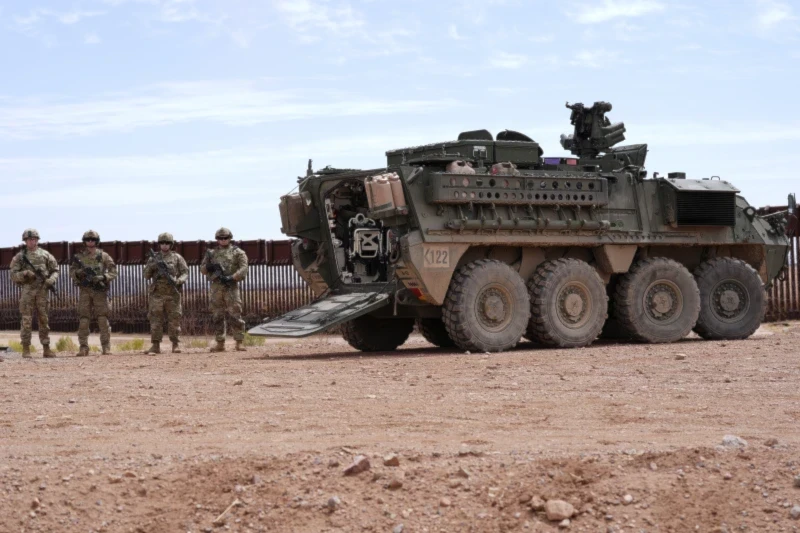10,000 US troops begin arriving at Mexico border for support
The Trump administration has started sending 10,000 troops to the US-Mexico border to assist with surveillance and support Border Patrol prompting concern among local residents and experts about growing militarization.
-
 US Army men stand next to an M1126 Stryker at the US-Mexico border, April 3, 2025, in Arizona (AP/Ross D. Franklin)
US Army men stand next to an M1126 Stryker at the US-Mexico border, April 3, 2025, in Arizona (AP/Ross D. Franklin)
The Trump administration’s deployment of 10,000 troops to the southern US border is now underway, with soldiers arriving in towns along the frontier. This military move comes despite a recent decline in unauthorized border crossings. Still, President Trump remains committed to his broader plan to militarize the border with Mexico.
These troops are not tasked with apprehending undocumented migrants. Instead, their role is to assist US Border Patrol agents with surveillance, intelligence gathering, and logistical support, serving as an extra set of eyes on the ground.
“We will not be actively on patrols,” said Maj. Jaren Stafani at a press conference. “We'll be at detection and monitoring sites to provide that information to [the] Border Patrol to then go out and do their law enforcement function.”
Maj. Stefani, who leads the deployment in the Big Bend sector of Texas, emphasized that this operation aligns with the Posse Comitatus Act, which restricts the military from engaging in civilian law enforcement, with limited exceptions.
Locals react to a growing military presence
Despite the legal framework guiding the troops' mission, many local residents feel uneasy about the transformation of their communities. In Presidio, Texas, some fear the increased presence of military hardware is turning their town into something more closely resembling a war zone.
“I feel like they're basically turning this place into a military zone, or a wanna-be conflict zone when in reality it isn't,” said Anibal Galindo, a longtime resident of Presidio.
The US military has been installing equipment typically used in foreign combat operations. Stryker armored vehicles, for instance, have been stationed near the border. Navy destroyers are also being used as part of the effort. Meanwhile, the CIA has increased drone surveillance over Mexico, a program that began under the Biden administration. These drones are intended to relay information to the Mexican government.
While the growing military footprint could strain diplomatic relations between Mexico and the US, experts suggest that the root of the issue lies in Washington’s evolving strategy to combat drug cartels.
Redefining the cartel fight
Earlier this year, the Trump administration designated several major drug cartels as Foreign Terrorist Organizations (FTOs), a move that could potentially lead to military operations on Mexican soil.
“By designating drug cartels as FTOs, the Trump administration unlocks new powers for itself, creates a new media narrative that could fool many, and reinforces the rest of its anti-immigration and border enforcement agenda,” comments Alex Nowrasteh, Vice President for Economic and Social Policy Studies at the Cato Institute.
Using the US military to attack the Mexican cartels would risk another endless war for the United States.
— Cato Foreign Policy (@CatoFP) April 11, 2025
Writes @brandan_buck: https://t.co/MCUw6B8EEV
According to Nowrasteh, the designation allows the White House to impose economic consequences on Latin American nations that fail to align with Trump’s immigration goals, all while strengthening the administration’s political messaging that portrays the southern border as being invaded.
Supporters of a more aggressive approach have taken things a step further. Representative Dan Crenshaw has voiced support for direct US military involvement in Mexico’s fight against cartels, suggesting air support could be used to aid Mexican operations on the ground.
“We need to somehow figure out diplomatically how to make this Mexico’s idea. That they’re asking for our military support, such as close air support, such as an AC-130 gunship overhead while they’re prosecuting a target and surrounded by sicarios… If I was in that situation as a Navy SEAL, we would just call in close air support, all those guys would be gone, and we’d move along our merry way.”
Warnings about escalation
However, not everyone agrees with the increasing militarization of the region. Justin Logan, another analyst at the Cato Institute, argues that Mexico, while facing serious challenges, has not descended into cartel warfare on the scale once seen in South America.
“Despite seeing its homicide rate more than triple in less than two decades, Mexico is still nowhere near Colombia’s levels of violence during the Narcos era of the late 1980s and early 1990s, when the country reached the alarming rate of 85 homicides per 100,000 inhabitants. Comparing Mexico’s violence in 2023 to that of Colombia in 1993 borders on the preposterous.”
Logan points out that when the Mexican government militarized its anti-Cartel effort in the mid-2000s, homicide rates there tripled.
For now, residents in border towns are bracing for what lies ahead as the Trump administration continues deploying thousands of troops to the region.

 5 Min Read
5 Min Read










